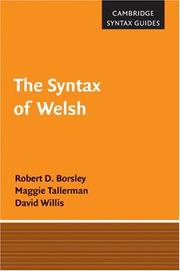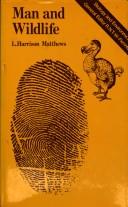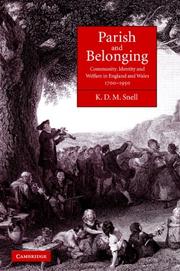| Listing 1 - 10 of 41 | << page >> |
Sort by
|
Periodical
ISSN: 23978716 09652450
Abstract | Keywords | Export | Availability | Bookmark
 Loading...
Loading...Choose an application
- Reference Manager
- EndNote
- RefWorks (Direct export to RefWorks)
Wales --- Economic conditions --- Cambria --- Cymric --- Gwalia --- Cymru --- England and Wales --- Economic history --- History, Economic --- Economics
Book
ISBN: 0511896956 0521214556 0521089468 Year: 1972 Publisher: Cambridge : Cambridge University Press,
Abstract | Keywords | Export | Availability | Bookmark
 Loading...
Loading...Choose an application
- Reference Manager
- EndNote
- RefWorks (Direct export to RefWorks)
The sources for the history of medieval Wales are scanty, sporadic and physically scattered. Neither in archival, narrative nor archaeological remains is Wales comparable to England, and what survives is less accessible, for there has been a notable reluctance among Welsh scholars to produce guides and surveys for this difficult corpus of material. The purpose of Medieval Wales is to examine the history and survival of records produced by administrations inside what is now Wales, princely, seigneurial, ecclesiastical, municipal; to indicate the relevance of English official records to students of Welsh history; to give an introduction to the main narrative sources; to put the work of the Welsh antiquaries into a wider context; to re-examine the whole question of independent Welsh coinage; and to bring together discussion of Welsh archaeological remains, place-name studies and early cartography.
Wales --- Cambria --- Cymric --- Gwalia --- Cymru --- England and Wales --- History --- Arts and Humanities
Book
ISBN: 191150715X 1911507141 Year: 2019 Publisher: London
Abstract | Keywords | Export | Availability | Bookmark
 Loading...
Loading...Choose an application
- Reference Manager
- EndNote
- RefWorks (Direct export to RefWorks)
Why do so few institutions in the legal sector have professional records managers or archivists on their staff? This book is the culmination of a three year project by experienced archivist and records managers on private sector legal records at risk in England at Wales. It summarises the work of the Legal Records at Risk (LRAR) project and its predecessors, diagnoses the problems of preservation of archives in the legal sector in England and Wales and outlines a national strategy for such records.
Law --- England. --- Wales. --- Cambria --- Cymric --- Cymru --- Gwalia --- Angleterre --- Anglii͡ --- Anglija --- Engeland --- Inghilterra --- Inglaterra
Periodical
ISSN: 02608295 Publisher: Cardiff : National Assembly for Wales
Abstract | Keywords | Export | Availability | Bookmark
Book
ISBN: 1107338166 1108066364 Year: 1793 Publisher: Place of publication not identified : Cambridge : publisher not identified, Cambridge University Press
Abstract | Keywords | Export | Availability | Bookmark
 Loading...
Loading...Choose an application
- Reference Manager
- EndNote
- RefWorks (Direct export to RefWorks)
The humorously self-styled 'late' Thomas Pennant (1726-98) published this short autobiographical survey in 1793. A prominent Welsh naturalist and antiquary, he was known more for his energy and meticulous methodology than for original scientific genius. Yet he helped popularise natural history with beautifully illustrated works such as his History of Quadrupeds, the third edition of which is also reissued in this series. Moreover, he is credited with preserving thorough records of antiquities that were later damaged or destroyed. Samuel Johnson, who toured Scotland after Pennant, praised him as 'the best traveller I ever read'. More than a mere travelogue, Pennant's Literary Life is full of delightful vignettes - his meeting with the 'wicked wit' Voltaire, his affection for his faithful servant and illustrator Moses Griffith, and his poetic critique of certain hypocritical clergy. The appendices contain several of Pennant's shorter pieces on diverse topics, from anthropology to politics.
Zoologists --- Patagonians --- Wales --- Politics and government --- Indians of South America --- Animal scientists --- Biologists --- Cambria --- Cymric --- Gwalia --- Cymru --- England and Wales
Book
ISBN: 9780708324349 0708324347 9780708324356 0708324355 1299201148 9780708326381 0708326382 9781299201149 Year: 2011 Publisher: Cardiff : University of Wales,
Abstract | Keywords | Export | Availability | Bookmark
 Loading...
Loading...Choose an application
- Reference Manager
- EndNote
- RefWorks (Direct export to RefWorks)
The book explores the complex and shifting geographies of rural Wales in the twenty first century. Written by experts in their fields and drawing on a broad range of academic work, the book focuses on social, cultural, economic, welfare and environmental themes. Particular attention is given to the changing relations between people, place and environment in rural Wales. The book uses these accounts of the social, economic and environmental geographies of rural Wales to provide a broader critique of rural geography and rural studies in the UK and other developed countries.
Wales --- Economic conditions --- Social conditions --- Environmental conditions. --- Wales -- Rural conditions. --- Wales. --- Cambria --- Cymric --- Gwalia --- Cymru --- England and Wales --- Rural conditions. --- E-books

ISBN: 9780521836302 0521836301 9780511486227 9781107407619 0511366159 9780511366154 9780511367397 0511367392 0511486227 1107174864 9781107174863 1281146013 9781281146014 9786611146016 6611146016 1139130692 9781139130691 0511366809 9780511366802 0511365527 9780511365522 1107407613 Year: 2007 Publisher: Cambridge Cambridge University Press
Abstract | Keywords | Export | Availability | Bookmark
 Loading...
Loading...Choose an application
- Reference Manager
- EndNote
- RefWorks (Direct export to RefWorks)
Welsh, like the other Celtic languages, is best known amongst linguists for its verb-initial word order and its use of initial consonant mutations. However it has many more characteristics which are of interest to syntacticians. This book, first published in 2007, provides a concise and accessible overview of the major syntactic phenomena of Welsh. A broad variety of topics are covered, including finite and infinitival clauses, noun phrases, agreement and tense, word order, clause structure, dialect variation, and the language's historical Celtic background. Drawing on work carried out in both Principles and Parameters theory and Head-driven Phrase Structure Grammar, it takes contemporary colloquial Welsh as its starting point and draws contrasts with a range of literary and dialectal forms of the language, as well as earlier forms (Middle Welsh) were appropriate. An engaging guide to all that is interesting about Welsh syntax, this book will be welcomed by syntactic theorists, typologists, historical linguists and Celticists alike.
Welsh language --- Cambrian language --- Cambric language --- Cymraeg language --- Cymric language --- Brythonic languages --- Syntax. --- Syntax --- Celtic languages --- Celtic philology --- Indo-European languages --- Arts and Humanities --- Language & Linguistics

ISBN: 0856640123 0856640441 Year: 1973 Publisher: London : Croom Helm,
Abstract | Keywords | Export | Availability | Bookmark
 Loading...
Loading...Choose an application
- Reference Manager
- EndNote
- RefWorks (Direct export to RefWorks)
Great Britain --- Wales --- Population --- -History. --- History. --- Cambria --- Cymric --- Gwalia --- Cymru --- England and Wales --- Revolution industrielle --- Demographie --- Grande-bretagne --- Angleterre --- Histoire --- 19e-20e siecles --- Conditions economiques --- 18e-19e siecles --- Conditions sociales

ISBN: 9780521862929 9780511496059 9780521110754 9780511261305 0511261306 0511259506 9780511259500 0511260172 9780511260179 0511260733 9780511260735 0511496052 0521862922 128074930X 9781280749308 9786610749300 6610749302 0521862922 1107168767 9781107168763 0511319711 9780511319716 0521110750 Year: 2009 Publisher: Cambridge Cambridge University Press
Abstract | Keywords | Export | Availability | Bookmark
 Loading...
Loading...Choose an application
- Reference Manager
- EndNote
- RefWorks (Direct export to RefWorks)
What role did the parish play in people's lives in England and Wales between 1700 and the mid-twentieth century? By comparison with globalisation and its dislocating effects, the book stresses how important parochial belonging once was. Professor Snell discusses themes such as settlement law and practice, marriage patterns, cultures of local xenophobia, the continuance of out-door relief in people's own parishes under the new poor law, the many new parishes of the period and their effects upon people's local attachments. The book highlights the continuing vitality of the parish as a unit in people's lives, and the administration associated with it. It employs a variety of historical methods, and makes important contributions to the history of welfare, community identity and belonging. It is highly relevant to the modern themes of globalisation, de-localisation, and the decline of community, helping to set such changes and their consequences into local historical perspective.
Parishes --- History of the United Kingdom and Ireland --- anno 1700-1799 --- anno 1800-1999 --- History --- England --- Wales --- Social conditions --- Church polity --- Cambria --- Cymric --- Gwalia --- Cymru --- England and Wales --- History. --- Arts and Humanities
Book
ISBN: 0122192508 0122192524 9780122192524 Year: 1978 Publisher: London
Abstract | Keywords | Export | Availability | Bookmark
 Loading...
Loading...Choose an application
- Reference Manager
- EndNote
- RefWorks (Direct export to RefWorks)
England --- Wales --- Historical geography. --- Pays de Galles --- Historische geografie --- Groot-Brittanië. --- History of the United Kingdom and Ireland --- Cambria --- Cymric --- Gwalia --- Cymru --- England and Wales --- Geografie --- Landschapskunde --- Angleterre --- Géographie historique --- GEOGRAPHIE HISTORIQUE --- ANGLETERRE --- PAYS DE GALLES
| Listing 1 - 10 of 41 | << page >> |
Sort by
|

 Search
Search Feedback
Feedback About UniCat
About UniCat  Help
Help News
News